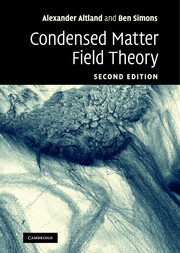Book contents
- Frontmatter
- Contents
- Preface
- 1 From particles to fields
- 2 Second quantization
- 3 Feynman path integral
- 4 Functional field integral
- 5 Perturbation theory
- 6 Broken symmetry and collective phenomena
- 7 Response functions
- 8 The renormalization group
- 9 Topology
- 10 Nonequilibrium (classical)
- 11 Nonequilibrium (quantum)
- Index
6 - Broken symmetry and collective phenomena
Published online by Cambridge University Press: 04 August 2010
- Frontmatter
- Contents
- Preface
- 1 From particles to fields
- 2 Second quantization
- 3 Feynman path integral
- 4 Functional field integral
- 5 Perturbation theory
- 6 Broken symmetry and collective phenomena
- 7 Response functions
- 8 The renormalization group
- 9 Topology
- 10 Nonequilibrium (classical)
- 11 Nonequilibrium (quantum)
- Index
Summary
Previously, we have seen how the field integral method can be deployed to formulate perturbative approximation schemes to explore weakly interacting theories. In this chapter, we will learn how elements of the perturbative approach can be formulated more efficiently by staying firmly within the framework of the field integral. More importantly, in doing so, we will see how the field integral provides a method for identifying and exploring non-trivial reference ground states – “mean-fields.” A fusion of perturbative and mean-field methods will provide us with analytical machinery powerful enough to address a spectrum of rich applications ranging from superfluidity and superconductivity to metallic magnetism and the interacting electron gas.
As mentioned in Chapter 5, the perturbative machinery is but one part of a larger framework. In fact, the diagrammatic series already contained hints indicating that a straightforward expansion of a theory in the interaction operator might not always be an optimal strategy: all previous examples that contained a large parameter “N” – and usually it is only problems of this type that are amenable to controlled analytical analysis – shared the property that the diagrammatic analysis bore structures of “higher complexity.” (For example, series of polarization operators appeared rather than series of the elementary Green functions, etc.) This phenomenon suggests that large-N problems should qualify for a more efficient and, indeed, a more physical formulation.
- Type
- Chapter
- Information
- Condensed Matter Field Theory , pp. 242 - 359Publisher: Cambridge University PressPrint publication year: 2010



